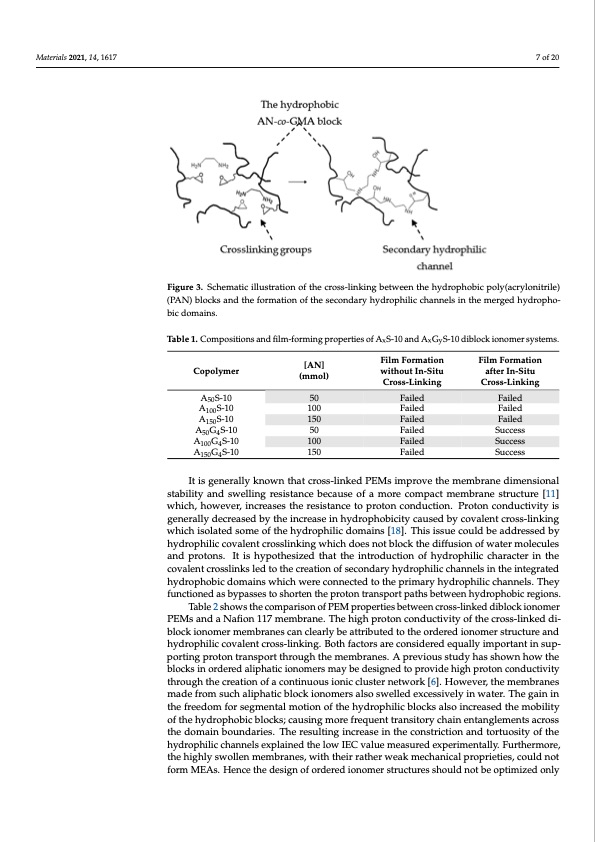
PDF Publication Title:
Text from PDF Page: 007
Materials 2021, 14, 1617 introduced during membrane casting to form a covalently cross-linked network with hy- drophilic character (Figure 3). A designated cross-linker such as an organic diamine [R(NH2)2], EDA, was added to the casting solution. Upon drying the cast membrane, the reaction between the diamine molecules and the pendant epoxide groups of GMA estab- 7 of 20 lished a covalently bonded network between the hydrophobic (poly(acrylonitrile) (PAN)- co-GMA) blocks, allowing freestanding membranes to be made. Figure 3. Schematic illustration of the cross-linking between the hydrophobic poly(acrylonitrile) (PAN) blocks and the formation of the secondary hydrophilic channels in the merged hydropho- bic domains. Table 1. Compositions and film-forming properties of AxS-10 and AxGyS-10 diblock ionomer systems. Copolymer A50 S-10 A100 S-10 A150 S-10 A50 G4 S-10 A100 G4 S-10 A150 G4 S-10 [AN] Film Formation (mmol) without In-Situ Cross-Linking 50 Failed 100 Failed 150 Failed 50 Failed 100 Failed 150 Failed Film Formation after In-Situ Cross-Linking Failed Failed Failed Success Success Success It is generally known that cross-linked PEMs improve the membrane dimensional stability and swelling resistance because of a more compact membrane structure [11] which, however, increases the resistance to proton conduction. Proton conductivity is generally decreased by the increase in hydrophobicity caused by covalent cross-linking which isolated some of the hydrophilic domains [18]. This issue could be addressed by hydrophilic covalent crosslinking which does not block the diffusion of water molecules and protons. It is hypothesized that the introduction of hydrophilic character in the covalent crosslinks led to the creation of secondary hydrophilic channels in the integrated hydrophobic domains which were connected to the primary hydrophilic channels. They functioned as bypasses to shorten the proton transport paths between hydrophobic regions. Table 2 shows the comparison of PEM properties between cross-linked diblock ionomer PEMs and a Nafion 117 membrane. The high proton conductivity of the cross-linked di- block ionomer membranes can clearly be attributed to the ordered ionomer structure and hydrophilic covalent cross-linking. Both factors are considered equally important in sup- porting proton transport through the membranes. A previous study has shown how the blocks in ordered aliphatic ionomers may be designed to provide high proton conductivity through the creation of a continuous ionic cluster network [6]. However, the membranes made from such aliphatic block ionomers also swelled excessively in water. The gain in the freedom for segmental motion of the hydrophilic blocks also increased the mobility of the hydrophobic blocks; causing more frequent transitory chain entanglements across the domain boundaries. The resulting increase in the constriction and tortuosity of the hydrophilic channels explained the low IEC value measured experimentally. Furthermore, the highly swollen membranes, with their rather weak mechanical proprieties, could not form MEAs. Hence the design of ordered ionomer structures should not be optimized onlyPDF Image | Hydrophilic Cross-Linked Aliphatic Hydrocarbon Diblock Copolymer

PDF Search Title:
Hydrophilic Cross-Linked Aliphatic Hydrocarbon Diblock CopolymerOriginal File Name Searched:
materials-14-01617.pdfDIY PDF Search: Google It | Yahoo | Bing
NFT (Non Fungible Token): Buy our tech, design, development or system NFT and become part of our tech NFT network... More Info
IT XR Project Redstone NFT Available for Sale: NFT for high tech turbine design with one part 3D printed counter-rotating energy turbine. Be part of the future with this NFT. Can be bought and sold but only one design NFT exists. Royalties go to the developer (Infinity) to keep enhancing design and applications... More Info
Infinity Turbine IT XR Project Redstone Design: NFT for sale... NFT for high tech turbine design with one part 3D printed counter-rotating energy turbine. Includes all rights to this turbine design, including license for Fluid Handling Block I and II for the turbine assembly and housing. The NFT includes the blueprints (cad/cam), revenue streams, and all future development of the IT XR Project Redstone... More Info
Infinity Turbine ROT Radial Outflow Turbine 24 Design and Worldwide Rights: NFT for sale... NFT for the ROT 24 energy turbine. Be part of the future with this NFT. This design can be bought and sold but only one design NFT exists. You may manufacture the unit, or get the revenues from its sale from Infinity Turbine. Royalties go to the developer (Infinity) to keep enhancing design and applications... More Info
Infinity Supercritical CO2 10 Liter Extractor Design and Worldwide Rights: The Infinity Supercritical 10L CO2 extractor is for botanical oil extraction, which is rich in terpenes and can produce shelf ready full spectrum oil. With over 5 years of development, this industry leader mature extractor machine has been sold since 2015 and is part of many profitable businesses. The process can also be used for electrowinning, e-waste recycling, and lithium battery recycling, gold mining electronic wastes, precious metals. CO2 can also be used in a reverse fuel cell with nafion to make a gas-to-liquids fuel, such as methanol, ethanol and butanol or ethylene. Supercritical CO2 has also been used for treating nafion to make it more effective catalyst. This NFT is for the purchase of worldwide rights which includes the design. More Info
NFT (Non Fungible Token): Buy our tech, design, development or system NFT and become part of our tech NFT network... More Info
Infinity Turbine Products: Special for this month, any plans are $10,000 for complete Cad/Cam blueprints. License is for one build. Try before you buy a production license. May pay by Bitcoin or other Crypto. Products Page... More Info
| CONTACT TEL: 608-238-6001 Email: greg@infinityturbine.com | RSS | AMP |